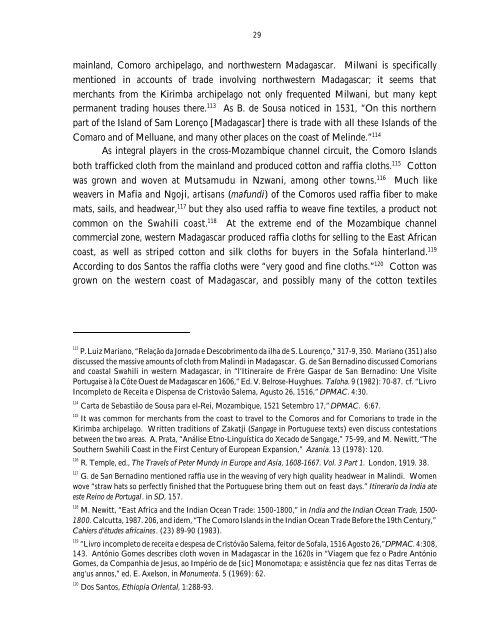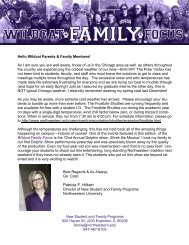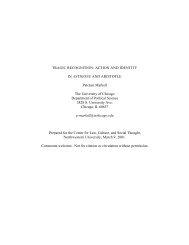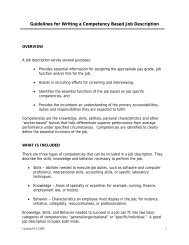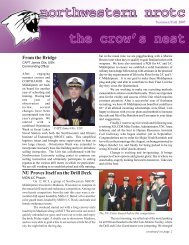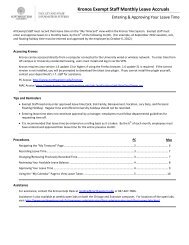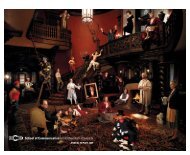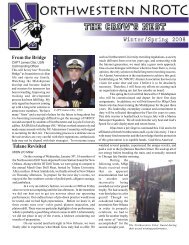Artistry Permits and Custom May Ordain - Northwestern University
Artistry Permits and Custom May Ordain - Northwestern University
Artistry Permits and Custom May Ordain - Northwestern University
You also want an ePaper? Increase the reach of your titles
YUMPU automatically turns print PDFs into web optimized ePapers that Google loves.
29<br />
mainl<strong>and</strong>, Comoro archipelago, <strong>and</strong> northwestern Madagascar. Milwani is specifically<br />
mentioned in accounts of trade involving northwestern Madagascar; it seems that<br />
merchants from the Kirimba archipelago not only frequented Milwani, but many kept<br />
permanent trading houses there. 113 As B. de Sousa noticed in 1531, “On this northern<br />
part of the Isl<strong>and</strong> of Sam Lorenço [Madagascar] there is trade with all these Isl<strong>and</strong>s of the<br />
Comaro <strong>and</strong> of Melluane, <strong>and</strong> many other places on the coast of Melinde.” 114<br />
As integral players in the cross-Mozambique channel circuit, the Comoro Isl<strong>and</strong>s<br />
both trafficked cloth from the mainl<strong>and</strong> <strong>and</strong> produced cotton <strong>and</strong> raffia cloths. 115 Cotton<br />
was grown <strong>and</strong> woven at Mutsamudu in Nzwani, among other towns. 116 Much like<br />
weavers in Mafia <strong>and</strong> Ngoji, artisans (mafundi) of the Comoros used raffia fiber to make<br />
mats, sails, <strong>and</strong> headwear, 117 but they also used raffia to weave fine textiles, a product not<br />
common on the Swahili coast. 118 At the extreme end of the Mozambique channel<br />
commercial zone, western Madagascar produced raffia cloths for selling to the East African<br />
coast, as well as striped cotton <strong>and</strong> silk cloths for buyers in the Sofala hinterl<strong>and</strong>. 119<br />
According to dos Santos the raffia cloths were “very good <strong>and</strong> fine cloths.” 120 Cotton was<br />
grown on the western coast of Madagascar, <strong>and</strong> possibly many of the cotton textiles<br />
113 P. Luiz Mariano, “Relação da Jornada e Descobrimento da ilha de S. Lourenço,” 317-9, 350. Mariano (351) also<br />
discussed the massive amounts of cloth from Malindi in Madagascar. G. de San Bernadino discussed Comorians<br />
<strong>and</strong> coastal Swahili in western Madagascar, in “l’Itineraire de Frère Gaspar de San Bernadino: Une Visite<br />
Portugaise à la Côte Ouest de Madagascar en 1606,” Ed. V. Belrose-Huyghues. Taloha. 9 (1982): 70-87. cf. “Livro<br />
Incompleto de Receita e Dispensa de Cristovão Salema, Agusto 26, 1516,” DPMAC. 4:30.<br />
114 Carta de Sebastião de Sousa para el-Rei, Mozambique, 1521 Setembro 17,” DPMAC. 6:67.<br />
115 It was common for merchants from the coast to travel to the Comoros <strong>and</strong> for Comorians to trade in the<br />
Kirimba archipelago. Written traditions of Zakatji (Sangage in Portuguese texts) even discuss contestations<br />
between the two areas. A. Prata, “Análise Etno-Linguística do Xecado de Sangage,” 75-99, <strong>and</strong> M. Newitt, “The<br />
Southern Swahili Coast in the First Century of European Expansion,” Azania. 13 (1978): 120.<br />
116 R. Temple, ed., The Travels of Peter Mundy in Europe <strong>and</strong> Asia, 1608-1667. Vol. 3 Part 1. London, 1919. 38.<br />
117 G. de San Bernadino mentioned raffia use in the weaving of very high quality headwear in Malindi. Women<br />
wove “straw hats so perfectly finished that the Portuguese bring them out on feast days.” Itinerario da India ate<br />
este Reino de Portugal. in SD, 157.<br />
118 M. Newitt, “East Africa <strong>and</strong> the Indian Ocean Trade: 1500-1800,” in India <strong>and</strong> the Indian Ocean Trade, 1500-<br />
1800. Calcutta, 1987. 206, <strong>and</strong> idem, “The Comoro Isl<strong>and</strong>s in the Indian Ocean Trade Before the 19th Century,”<br />
Cahiers d’études africaines. (23) 89-90 (1983).<br />
119 “Livro incompleto de receita e despesa de Cristóvão Salema, feitor de Sofala, 1516 Agosto 26,” DPMAC. 4:308,<br />
143. António Gomes describes cloth woven in Madagascar in the 1620s in “Viagem que fez o Padre António<br />
Gomes, da Companhia de Jesus, ao Império de de [sic] Monomotapa; e assistência que fez nas ditas Terras de<br />
ang‘us annos,” ed. E. Axelson, in Monumenta. 5 (1969): 62.<br />
120 Dos Santos, Ethiopia Oriental, 1:288-93.


